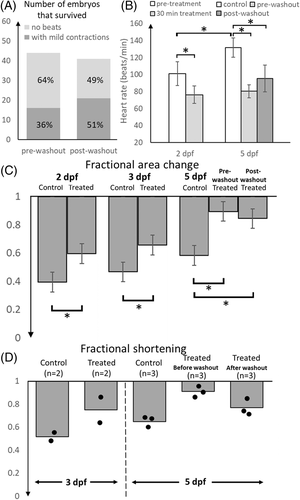Image
Figure Caption
Fig. 3
(A) The number of zebrafish embryos that survived with no heartbeat or mild contractions was assessed. Number of embryos with mild contraction increased from 36% (16/44) to 51% (21/41), suggesting that the washout partially restores heart contractility. (B) The heart rate (n = 7) dropped by 25% within 30 minutes of treatment at 2 dpf. At 5 dpf, the heart rate of treated hearts before washout (n = 15) was far lower than that of control (n = 20) but washout increased heart rate by 19% (n = 20). Note that the treated embryos with no heartbeats were excluded in this calculation. (C) Ventricular fractional area changes from systole to diastole of control (n = 10) and treated hearts (n = 10), calculated from 2D microscopy, evaluated based on the end-systole which was normalized to the end-diastole at 2, 3, and 5 dpf, respectively. For B-C, mean and standard deviations were presented and a two-sample t-test was used, where *P < 0.05. (D) Fractional shortening, a metric of myocardial contractility, measured from cardiac motion tracking of 3D LSFMM microscopy images, taking the end-diastole state as the zero stretch reference, at 3 and 5 dpf
Acknowledgments
This image is the copyrighted work of the attributed author or publisher, and
ZFIN has permission only to display this image to its users.
Additional permissions should be obtained from the applicable author or publisher of the image.
Full text @ Dev. Dyn.

